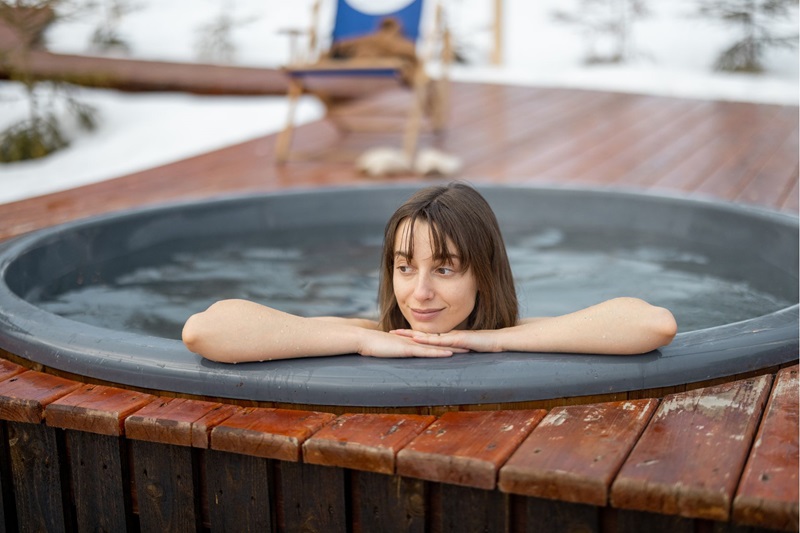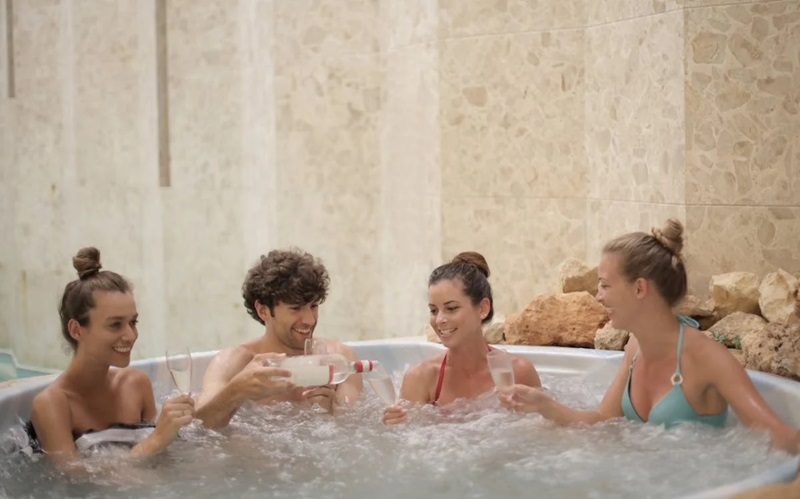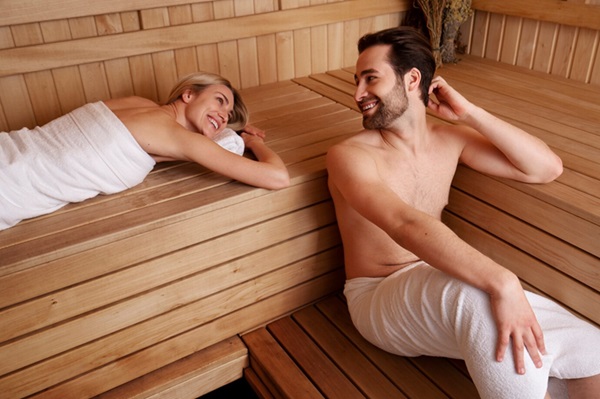Hot tubs are a source of immense physical, mental, and health benefits. In this blog, we will explore the numerous benefits and advantages of hot tubs and provide guidelines for their safe and effective use.
Ready to experience the ultimate in relaxation and wellness? Shym Saunas offers a range of high-quality hot tubs designed to provide maximum benefits for your health and well-being. Visit our website or contact us today to find the perfect hot tub for your home.
Key takeaways
- Hot Tub Physical Benefits: Hot tubs relieve stress, ease muscle tension, improve sleep quality, and provide pain relief for arthritis and fibromyalgia.
- Mental Benefits: Hot tubs promote relaxation, improve mood, and offer a setting for social connections.
- Specific Health Benefits: Hot tubs can help with muscle recovery, joint pain relief, and potential weight loss. They also enhance cardiovascular health by increasing heart rate and lowering blood pressure.
- Take note of risks: Hot tubs can pose risks for heart conditions, pregnancy, respiratory issues, skin conditions, and neurological conditions. They can cause dehydration, particularly for those with fluid balance issues.
- Keep the Best Practices: Keep water temperature between 39°C and 40°C, stay hydrated, limit soak time to 15-20 minutes, shower after use, and ensure hot tub safety with proper maintenance and barriers.
- Always consult a healthcare provider for tailored advice if you have health concerns or are pregnant.
Are Hot Tubs Healthy for You?

Exploring the advantages of hot tubs reveals a lot of health benefits that extend beyond simple relaxation. Hot tubs are often associated with luxury and leisure, but they can have a great impact on your health: Dipping into a hot tub might be more beneficial than you think! Here are the benefits of using a hot tub, from physical, mental, and specific health benefits:
Physical Benefits
1. Muscle Relaxation
Hot tubs are excellent for soothing tight and tense muscles. The warm water increases blood flow to your muscles, helping them relax and reducing soreness. This can be particularly beneficial before a workout to prevent injuries or after physical activity to aid in recovery.
According to Brittanica, when you apply heat to a sore area, it helps by widening blood vessels. This increase in blood flow carries away lactic acid (a substance that builds up in muscles during intense exercise) and toxins from tired muscles. The heat also makes muscles more flexible and activates nerve endings to reduce pain signals.
2. Improved Sleep
Research has shown that soaking in a hot tub can improve sleep quality. The relaxation induced by the warm water can help you fall asleep faster and enjoy a deeper, more restful sleep. This is particularly useful for individuals suffering from insomnia or other sleep disorders.
According to Dr. Mariyam Hassan Malik, taking a warm bath before bed can improve sleep by raising your body temperature. The subsequent drop in temperature after bathing signals your body that it’s time to sleep, helping you fall asleep faster. This process encourages a natural transition to rest.
3. Pain Relief
Soaking in a hot tub can provide relief from various types of pain, including arthritis and chronic pain conditions. The buoyancy of the water supports your body, reducing the strain on joints and muscles, while the heat helps to reduce inflammation and increase mobility.
Medical/ Health Benefits
4. Cardiovascular Health
Regular use of a hot tub can benefit your cardiovascular health by lowering blood pressure and improving circulation. The heat from the water causes blood vessels to dilate, enhancing blood flow and reducing strain on the heart. This can be particularly beneficial for individuals with high blood pressure or heart disease.
5. Improved Insulin Sensitivity
There is some evidence to suggest that regular use of hot tubs can improve insulin sensitivity, making it easier to manage conditions like diabetes. The heat and relaxation can help regulate blood sugar levels and improve overall metabolic function.
6. Calorie Burn
While not a substitute for exercise, soaking in a hot tub can help burn calories. A 2016 study found that participants burned a similar number of calories during a one-hour hot bath as they would during a 30-minute walk. This can be particularly beneficial for those who find traditional exercise challenging.
Mental Benefits

Image Credits: Pexels
7. Stress Relief
One of the most immediate benefits of using a hot tub is the reduction of stress. The combination of warm water and the massaging action of the jets can help alleviate both physical and mental tension.
Adding elements like soft music, low lighting, or aromatherapy can enhance this effect, making your hot tub session a truly relaxing experience.
8. Improved Mood
The relaxation and stress relief provided by hot tubs can lead to an improved mood. The warm water and jets stimulate the production of endorphins, which are the body’s natural feel-good hormones. This can help reduce anxiety and depression, leaving you feeling happier and more relaxed.
Risks of Hot Tub Use
Hot tubs are often seen as a luxurious way to relax and unwind. Yet, it’s important to be aware of the risks associated with hot tub use, especially for individuals with certain health conditions. Understanding these risks can help you make informed decisions and enjoy hot tubs safely.
Here are several key factors and health conditions that may increase the risks when using a hot tub.
Heart Conditions
The warmth of a hot tub can indeed be soothing, but it puts additional pressure on the heart. For those with heart conditions, this can lead to a drop in blood pressure, causing dizziness, lightheadedness, and, in severe cases, fainting or other cardiovascular complications. If you have a heart condition, it’s critical to consult your doctor before using a hot tub.
Pregnancy

Image Credits: Pixabay
For pregnant individuals, there are dangers of heat during pregnancy– elevated body temperatures can pose a risk to the developing fetus, potentially leading to birth defects. It is generally advised that pregnant women avoid hot tubs, especially during the early stages of pregnancy.
Respiratory Conditions
The steam and chemicals, like chlorine, emitted from hot tubs can exacerbate respiratory conditions such as asthma. The combination of steam and chemical fumes can irritate the respiratory system, making it harder to breathe for those with pre-existing respiratory issues.
Skin Conditions
If you have an open wound, skin infections, or conditions like eczema, you might want to think twice before hopping into a hot tub. The water can further irritate or infect your skin, leading to discomfort or more serious issues.
Neurological Conditions
For individuals with conditions like multiple sclerosis or Parkinson’s disease, sensing temperature changes can be challenging. This reduced sensitivity to heat can lead to overheating without even realizing it, posing a significant risk.
Dehydration
Hot tubs can increase the risk of dehydration, especially for those with health conditions that affect fluid balance in the body, like kidney disease or diabetes. Staying hydrated is key, but for those with these conditions, extra caution should be exercised.
Other Factors to Consider

Image Credits: Pexels
Medications
Some medications can increase your risk of adverse effects from hot tub use. It’s wise to check with your healthcare provider if your medications might make you more susceptible to overheating. Here are some examples and how they might pose risk of overheating:
- Antidepressants and Antipsychotics: These can affect the body’s ability to regulate temperature.
- Blood Pressure Medications: Medications like beta-blockers and diuretics can reduce the body’s ability to cool itself by affecting blood flow or causing dehydration.
- Antihistamines: These can decrease sweating and increase the risk of overheating as they can cause dry skin and reduce the body’s ability to dissipate heat.
- Muscle Relaxants: Medications used to relieve muscle spasms can lower the body’s tolerance to heat, increasing the risk of overheating.
- Sedatives and Tranquilizers: These can impair judgment and the ability to recognize overheating, which can be dangerous when using a hot tub.
Age and Developmental Stage
The very young and the elderly are more vulnerable to overheating due to difficulties in regulating body temperature. For young children and the elderly, limiting hot tub exposure is advisable.
Symptoms of Overheating
Be on the lookout for signs such as dizziness, nausea, excessive sweating, weakness, rapid breathing, headaches, flushed skin, thirst, confusion, or numbness. These symptoms can indicate overheating, a serious condition that requires immediate attention.
Hot Tub Rashes?
It’s true that properly maintained hot tubs should not cause rashes. Rashes usually result from chemical imbalances leading to bacterial presence in the water. If you experience a rash after hot tub use, consulting a doctor is a good step to take and to make sure what causes them.
NOTE: Following safety guidelines, such as limiting soak times, staying hydrated, and ensuring the hot tub is well-maintained, can help minimize these risks. Always consult your doctor if you’re unsure about hot tub use, especially if you belong to a higher-risk group.
Hot Tub Best Practices

Embracing good hot tub practices can significantly enhance your soaking experience, making it both enjoyable and safe. Here are actionable tips and insights to ensure a delightful and secure hot tub experience.
1. Monitor Water Temperature
For a start, always check the water temperature before you get in. The optimal range is between 39°C to 40°C. Exceeding 40°C can pose health risks, such as overheating or burns, especially if you enter the hot tub quickly without adjusting to the temperature gradually.
2. Stay Hydrated
Hot tubs are known for their relaxing effects, but they can also cause dehydration due to increased sweating. Drink plenty of water before, during, and after your hot tub session. However, steer clear of alcohol as it can further dehydrate you and even amplify the heat’s effects.
3. Limit Your Time
To avoid overheating and dehydration, limit your soak time to 15-20 minutes. If the water temperature is on the lower end of the optimal range and you’re accustomed to hot tub use, you might extend your session slightly longer. Pay attention to your body’s signals. If you start feeling dizzy, nauseous, or experience skin redness and shortness of breath, it’s time to get out.
4. Wash After Soaking
Always shower with soap and lukewarm water after using the hot tub. This practice helps remove any chemicals or bacteria from your skin, reducing the risk of infections such as hot tub folliculitis.
5. Safety First
If your hot tub is at home, ensure it’s secured with barriers and a locking cover to prevent accidents, especially with children around. For communal hot tubs, verify that they’re well-maintained and the water quality is regularly tested.
6. Health Precautions
Consult with a healthcare professional before using a hot tub if you have underlying health conditions or if you’re pregnant. They can provide personalized advice based on your medical history.
7. Recognize the Benefits
Besides relaxation, hot tubs offer various health benefits such as muscle recovery, stress relief, and improved sleep. Knowing the best practices for these benefits can help you tailor your hot tub sessions for maximum effect. For instance, soaking 90 minutes before bed can promote sleepiness due to the drop in body temperature after you exit the tub.
8. What To Do If You Feel Unwell
If you start feeling unwell in the hot tub, exit slowly to prevent accidents. Sit in a cooler area and drink water to combat dehydration. If symptoms like dizziness persist, take a break, lie down, and monitor your condition. Seek emergency medical help if your symptoms worsen or you have difficulty breathing.
Hot Tub vs Other Relaxing Activities
How does soaking in a hot tub compare to other relaxing activities, namely sauna, yoga, meditation, or traditional massage? Each has their own benefits and advantages, let’s find out where they differ.
Hot Tub vs. Sauna

Image Credit: Freepik
Saunas are excellent with similar benefits with hot tubs due to it being another form of a heat therapy. Saunas are good for detoxification and improving cardiovascular health, muscle recovery, stress relief, among others.
However, saunas might not be suitable for individuals who have difficulty tolerating high temperatures or those with certain cardiovascular conditions. Hot tubs, on the other hand, offer the soothing benefits of warm water and hydrotherapy, which can be gentler on the body while still providing significant health benefits.
Related: Hot Tub vs. Sauna: Or Should You Choose Both?
Hot Tub vs. Yoga
Yoga is excellent for enhancing flexibility, balance, and strength, offering significant mental health benefits such as stress relief, improved concentration, and enhanced self-awareness.
Of course, Yoga might not be suitable for those with severe joint or bone conditions. Hot tubs on the other hand provide gentle support and warmth, making them more accessible for individuals with physical limitations.
Additionally, hot tubs foster social interactions, offering a relaxing setting for gatherings which is quite contradictory to Yoga being an individual activity.
Hot Tub vs. Meditation
Meditation is outstanding for mental clarity and self-awareness, with physical benefits like lowering blood pressure and improving cardiovascular health. However, it can be challenging for individuals with attention disorders.
Hot tubs offer immediate physical relaxation that can aid mental relaxation, providing a more tactile form of stress relief. The warm water and jets stimulate endorphin production, enhancing mood and reducing anxiety, making hot tubs a more comprehensive solution for stress relief.
Hot Tub vs. Traditional Massage
Traditional massage provides targeted muscle manipulation, which can be highly effective for specific pain points and promotes stress relief and feelings of comfort and care. However, hot tubs offer continuous warmth and hydrotherapy, making them ideal for a more general and sustained relaxation experience. Hot tubs improve circulation, ease muscle and joint pain, and enhance sleep quality, while also offering a social aspect that massages typically do not.
FAQs
How long should you stay in a hot tub?
Most experts recommend soaking for 15-30 minutes at a time. This allows you to reap the benefits of warm water without overexposure to heat, which can lead to dehydration or overheating.
Is it good to go in a hot tub every day?
Yes, the benefits provided can be appreciated daily if you wish. Just remember to check with your doctor if you are unsure of any health risks for your personal situation.
How hot should a hot tub be?
To experience the benefits of hydrotherapy, a hot tub should be between 37.5 and 40°C.
Do hot tubs give you a rash?
Properly maintained hot tubs do not give you a rash. The most common cause of a rash is an imbalance in chemicals, which leads to bacteria being present in the water and subsequently affects your skin. Some people may have an allergy to certain chemicals but this is quite rare. If you are unsure about a rash or skin condition after hot tub use, please consult your doctor.
Can hot tubs help with arthritis?
Yes, the warm water and buoyancy of hot tubs can lessen the strain on joints, providing relief from arthritis pain by reducing stiffness and inflammation.
Are hot tubs beneficial for weight loss?
While hot tubs can support weight loss efforts by promoting relaxation and aiding in post-exercise recovery, they should not replace a healthy diet and regular exercise.
What precautions should I take before using a hot tub?
Avoid alcohol, stay hydrated, limit your time in the hot tub, especially if you’re pregnant or have heart problems, and ensure the water is clean and properly maintained to prevent infections.
How often should I change the water in my hot tub?
You should aim to drain, clean, and refill your hot tub every three months, or more frequently if it’s heavily used or poorly maintained. Regular water changes help prevent issues like murky water, foam, or algae blooms. If these problems occur, test and treat the water with appropriate chemicals; if they persist, a full drain, clean, and refill is necessary.
Is it necessary to cover my hot tub when not in use?
Yes, covering your hot tub helps to maintain water temperature, reduce evaporation, and keep out debris, making it more energy-efficient and easier to maintain.
Can I use household cleaning agents to clean my hot tub?
No, you should use cleaning products specifically designed for hot tubs to avoid damaging the components and affecting water balance.
How do I troubleshoot cloudy water in my hot tub?
Cloudy water can be due to several factors including imbalanced pH levels, high calcium hardness, or inadequate filtration. Test the water, adjust chemicals as needed, and clean or replace the filter.
What safety measures should I follow with my hot tub?
Always monitor the water temperature and chemical levels, ensure a secure cover when not in use, and never leave children unattended near the hot tub.
How can I save energy with my hot tub?
Keep the cover on when not in use, maintain the water and filter regularly to reduce the need for heating, and consider using a thermal blanket to reduce heat loss.
Is there a risk of dehydration while using a hot tub?
Yes, the heat can lead to sweating and dehydration. It’s important to stay hydrated by drinking water before and after hot tub use.
Is it safe for children to use hot tubs?
Children can be more sensitive to the heat and chemicals. Ensure they stay hydrated, limit their time in the hot tub, and never leave them unsupervised.
Wrapping Up
Hot tubs offer numerous health and relaxation benefits, including stress relief, muscle tension reduction, improved sleep, pain relief, and cardiovascular health enhancement. However, they do come with risks, especially for individuals with specific health conditions.
It’s essential to practice safety measures like monitoring water temperature, staying hydrated, limiting soak time, and consulting a healthcare provider if you have any health concerns. By following best practices, you can safely enjoy the many advantages hot tubs provide.
Ready to experience these benefits? Check out the high-quality hot tubs from Shym Saunas and find the perfect one for your home today!




